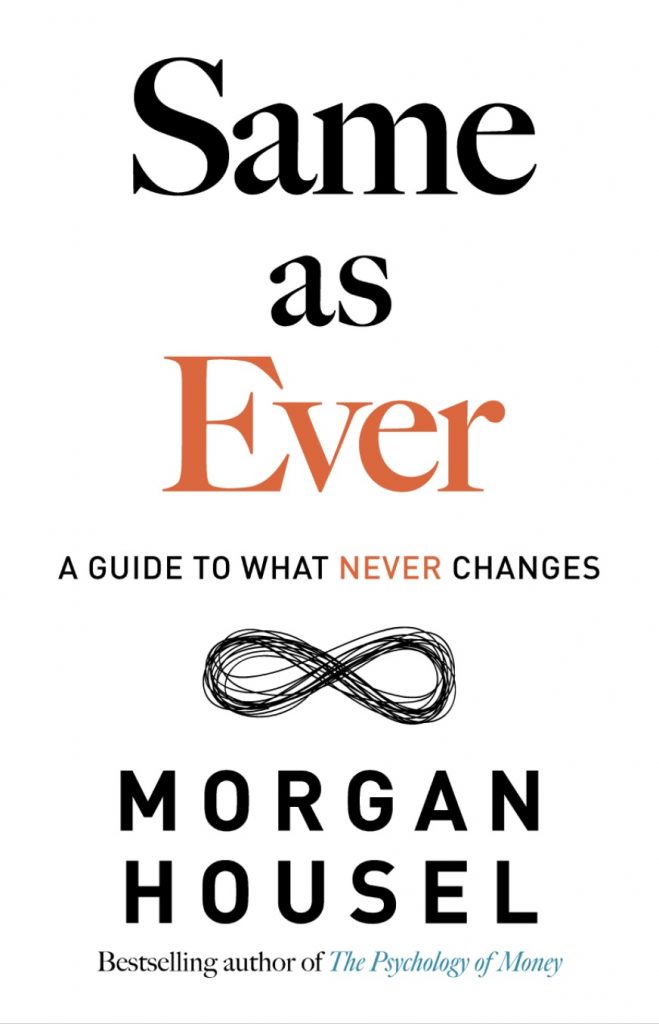Key Quote:
“A lot of what goes on in the prediction world is an attempt to rid yourself of the painful reality of not knowing what’s going to happen next. When you realize that making people feel better is more appealing than giving people useful figures, you start to see why thinking in probabilities is rare” (pp. 51-52).
Key Points and Concepts
Predicting the Future
“Amazon founder Jeff Bezos once said that he’s often asked what’s going to change in the next ten years. ‘I almost never get the question: “What’s not going to change in the next ten years?”’ he said. ‘And I submit to you that that second question is actually the more important of the two.’” (p. 2)
Because “[e]vents, like money, compound”, people chronically underestimate how difficult it is to make predictions about the future. The result of this is that we often do not foresee risks (pp. 14-19).
We take proactive measures to mitigate the risks we are aware of, but it’s the biggest risks which take us by surprise precisely because our “our imagination can’t fathom… the dangerous stuff” (p. 19).
If we cannot reasonably prepare for unimaginable risks, we should focus our attention on “preparedness” (p. 22).
In fact, setting reasonable expectations is more important than forecasting the future (p. 23).
When Comparison Becomes Dangerous
The 1950s—during which a single-income household could support a traditional family, purchase a home, own a car, take a vacation, and build savings—are treated with nostalgia and viewed as an economically superior decade (p. 26).
This nostalgia is grounded in a desire for financial balance and longing for a time before constant comparison to others dictated our ability to feel satisfied with our lives (p. 28).
We suffer because we prioritize chasing unrealistic expectations over managing our own circumstances (pp. 34-35).
Great Gifts and Unusual Personalities
Some of the most important innovators in our world have had eccentric personalities, habits, and ways of thinking—and because they seem different to us, we risk pushing them to the outskirts of society when their words and actions make us uncomfortable (pp. 36-43).
“Unique minds have to be accepted as a full package, because the things they do well and that we admire cannot be separated from the things we wouldn’t want for ourselves or we look down upon” (p. 37).
John Boyd—the author of the seminal manual on aerial fighting maneuvers—was considered rude and erratic and was frequently denied promotions (pp. 37-38).
Isaac Newton—who defined the laws of physics—had a strange obsession with magic and researching potions that would allow him to live forever (p. 39).
Elon Musk—pioneer of electric vehicles, aspiring colonizer of Mars, and tech visionary— publicly and flagrantly disregards the behavioral expectations of a CEO (pp. 39-40).
In hunting for role models, we must recognize the duality that often exists within them. “What kind of person makes their way to the top of a successful company, or a big country? Someone who is determined, optimistic, doesn’t take no for an answer, and is relentlessly confident in their own abilities. What kind of person is likely to go overboard, bite off more than they can chew, and discount risks that are blindingly obvious to others? Someone who is determined, optimistic, doesn’t take no for an answer, and is relentlessly confident in their own abilities” (p. 41).
Accuracy Versus Certainty
Humans crave certainty over accuracy because it makes them comfortable. As a result, they fail to apply probability to the real world in favor of focusing on black and white perspectives (pp. 45-46).
“A lot of what goes on in the prediction world is an attempt to rid yourself of the painful reality of not knowing what’s going to happen next. When you realize that making people feel better is more appealing than giving people useful figures, you start to see why thinking in probabilities is rare” (pp. 51-52).
Our contemporary global economy has increased the likelihood of “crazy” things happening. “When eight billion people interact, the odds of a fraudster, a genius, a terrorist, an idiot, a savant, a jerk, or a visionary moving the needle in a significant way on any given day is nearly guaranteed” (p. 49).
This phenomenon is reflected in modern news reporting; we are more likely to see a bad story on the evening news because the odds of a negative event happening somewhere in the world are “100 percent” (p. 51).
When and How Ideas Happen
Good ideas that are executed too quickly can become bad ideas. We obsess about making great things bigger and faster, and this obsession works against us (pp. 93-95).
In fact, the most significant innovations occur because of tragedy—specifically, “when the consequences of not acting quickly are too
painful to bear” (p. 96).
The Triangle Shirtwaist Factory fire of 1911 killed 146 workers but led to widespread labor reform—and, later, the first female appointment
to a presidential cabinet (pp. 96-98).
Resilience is built and innovation happens when everything is going wrong (p. 101).
“World War II began on horseback in 1939 and ended with nuclear fission in 1945. NASA was created in 1958, two weeks after the Soviets launched Sputnik, and landed on the moon just eleven years later. Stuff like that rarely happens that fast without fear as a motivator” (p. 106).
Consequently, good times often result in non-productive human behavior. Progress grinds to a halt when there are no problems to solve (pp. 107-108).
The Value of Imperfection and The Perils of Shortcuts
Evolution demonstrates that the pursuit of perfection is unnatural. Animals that evolve to possess one characteristic useful to survival generally find themselves vulnerable because of that characteristic (pp. 129-130).
“Not all jobs require creativity or critical thinking. But those that do function better with time devoted to wandering and being curious, in ways that are removed from scheduled work but actually help tackle your biggest work problems.” This is called “helpful inefficiency” (pp. 131-133).
There are no shortcuts as effective as learning to deal with discomfort. Pain is a part of our lived reality. “Hacks are appealing because they look like paths to prizes without the effort. But in the real world, those rarely exist” (pp. 137-138).
Rather than ask ourselves how to avoid inefficiency, we should ask: “What is the optimal amount to put up with so I can still function in a messy and imperfect world?” (p. 141).
Ultimately, functioning in the world entails acceptance of inefficiency—even if this idea is not yet widely accepted in the workplace.
“Many managers have little tolerance for nonsense. They think it’s noble. I demand excellence, they say. But it’s just unrealistic. The huge majority of them won’t thrive in their careers. Compounding is fueled by endurance, so sitting through periods of insanity is not a defect; it’s accepting an optimal level of hassle” (p. 142).
Long-Term Thinking and Opposing Worldviews
The kind of long-term thinking that enables us to survive disaster—financial or otherwise—requires the buy-in of the people significant to us: “partners, coworkers, spouses, and friends” (p. 179).
Two types of information inform our decision-making over time:
• Expiring information, which explains what occurred (p. 182).
• Permanent information, which explains why it occurred and considers the probability of it occurring again (p. 182).
• The latter allows us to compound and leverage information alongside our existing knowledge (p. 182).
• Our varying experiences shape how we view the world. “Experiencing something that makes you stare ruin in the face and question whether you’ll survive can permanently reset your expectations and change behaviors that were previously engrained” (p. 195).
• This can create misunderstanding for those who have not experienced the same events. “Disagreement has less to do with what people know and more to do with what they’ve experienced” (p. 199).
Final Questions
Housel suggests answering self-assessment questions, some of which include:
“Who has the right answers but I ignore because they’re not articulate?” (p. 201).
“What do I desperately want to be true so much that I think it’s true when it’s clearly not?” (p. 201).
“What are we ignoring today that will seem shockingly obvious in the future?” (p. 202).
“What hassle am I trying to eliminate that’s actually an unavoidable cost of success?” (p. 203).
“What strong belief do I hold that’s most likely to change?” (p. 203).
Housel, M. (2023). Same as Ever: A Guide to What Never Changes. New York: Portfolio/Penguin.

“A lot of what goes on in the prediction world is an attempt to rid yourself of the painful reality of not knowing what’s going to happen next. When you realize that making people feel better is more appealing than giving people useful figures, you start to see why thinking in probabilities is rare” (pp. 51-52).
“Our contemporary global economy has increased the likelihood of “crazy” things happening. “When eight billion people interact, the odds of a fraudster, a genius, a terrorist, an idiot, a savant, a jerk, or a visionary moving the needle in a significant way on any given day is nearly guaranteed.”
“M“Our contemporary global economy has increased the likelihood of “crazy” things = happening. “When eight billion people interact, the odds of a fraudster, a genius, a terrorist, an idiot, a savant, a jerk, or a visionary moving the needle in a significant way on any given day is nearly guaranteed.”
“Many managers have little tolerance for nonsense. They think it’s noble. I demand excellence, they say. But it’s just unrealistic. The huge majority of them won’t thrive in their careers. Compounding is fueled by endurance, so sitting through periods of insanity is not a defect; it’s accepting an optimal level of hassle.”
